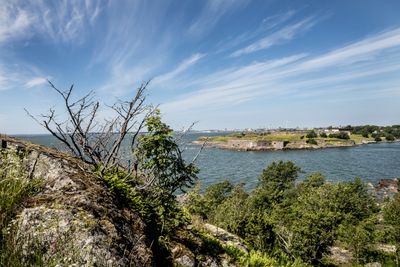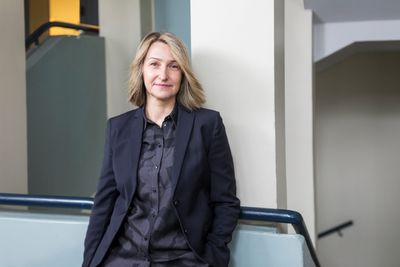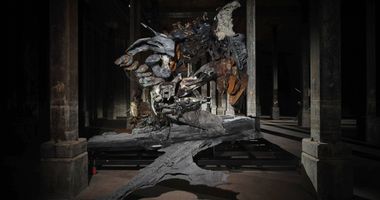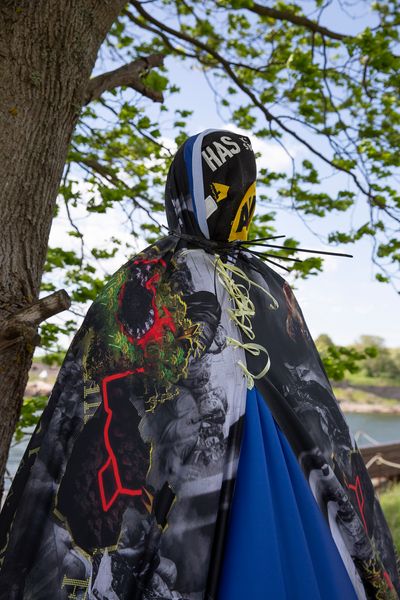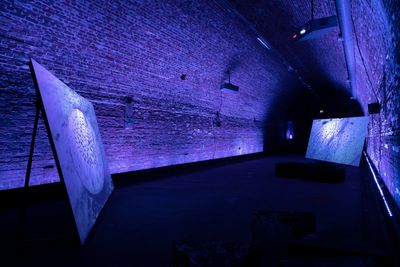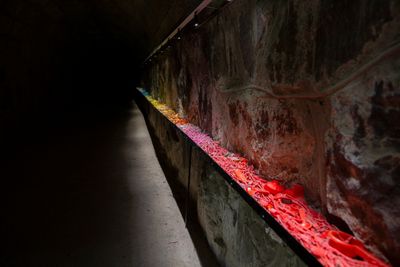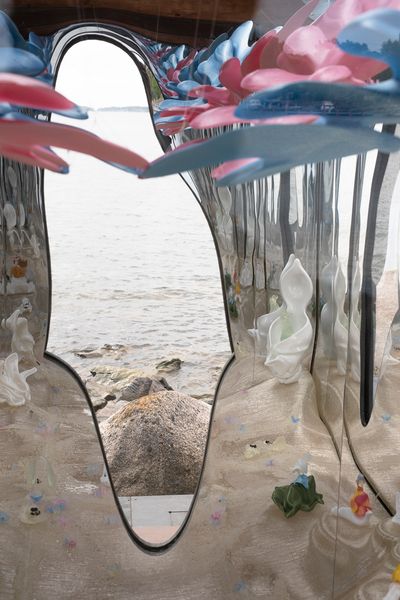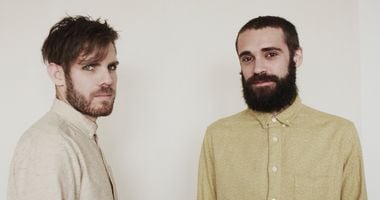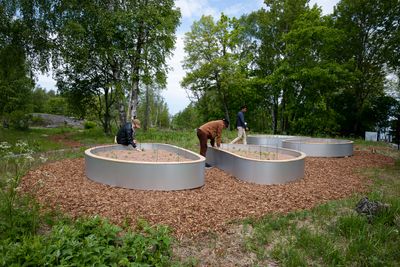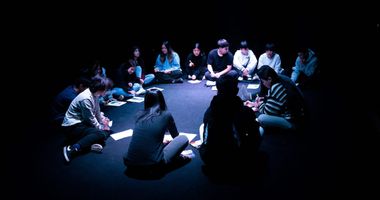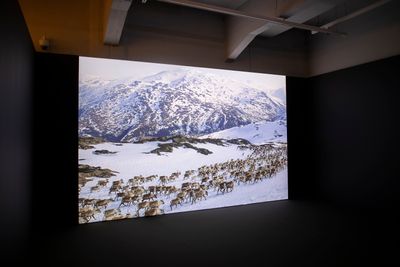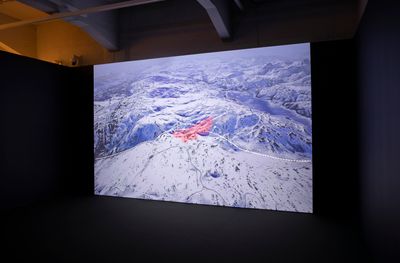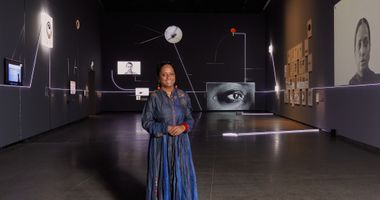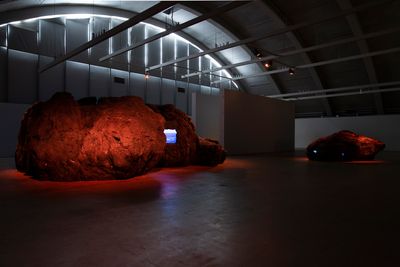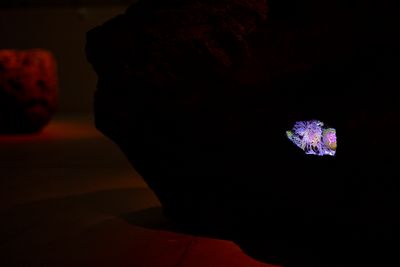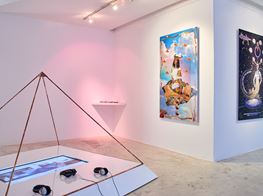Helsinki Biennial: Life After Ecological Devastation
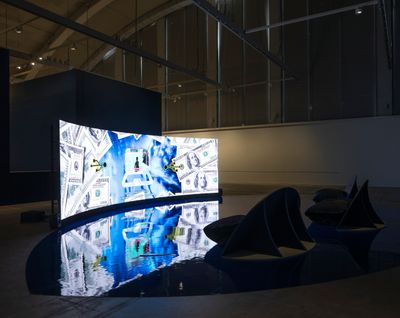
Tabita Rezaire, Deep Down Tidal (2017). Courtesy the artist and Goodman Gallery. Exhibition view: Helsinki Biennial 2023 (11 June–17 September 2023). Courtesy Helsinki Art Museum, Helsinki Biennial, and Kirsi Halkola.
Finland borders one of the most polluted bodies of water in the world—the Baltic Sea. Nodding to this, and to Finland's reliance on maritime industries, Helsinki inaugurated its first biennial The Same Sea in 2021, with its main site being the island of Vallisaari.
The key themes of interconnectedness and mutual dependence tied the island with global ecological crises, each connected by the same sea.
Vallisaari is one of some 330 islands on the Helsinki archipelago. A former Russian military base and now home to a flourishing natural ecosystem, the island once again hosts the Helsinki Biennial for its second iteration.
Comprising 29 artists, New Directions May Emerge (11 June–17 September 2023) examines the lasting effects of capitalism on global ecologies while positing reparative responses through site-specific works.
Curated by U.K.-based curator and scholar Joasia Krysa, the exhibition takes its name from a line in American anthropologist Anna Lowenhaupt Tsing's book, The Mushroom at the End of the World (2015): 'As contamination changes world-making projects, mutual worlds—and new directions—may emerge.'
Here, binaries of technology versus nature become obsolete, speaking to the three interconnected concepts of contamination, regeneration, and agency which Krysa deploys across the exhibition.
A trail of 18 artworks are positioned at various points around the island's perimeter. Certain works are scattered in unmarked locations to encourage the act of 'noticing', subtly woven into the landscape and its wartime buildings.
A total of 15 mutant sculptures forming From The Series the End of Imagination (2023) by Argentinian artist Adrián Villar Rojas appear throughout the island, each the result of complex 3D modelling software. Made from materials like concrete, plastic, glass and resin, and other organic and artificial materials, the forms appear like living entities, emerging from tree branches or from the ground like infected roots.
One such form that sits atop an old military fort features Lego-like gradations on its surface, rendered in two-tone shades of lime green and asphalt grey, with a thick amber-like unicorn horn emerging from its sides. Elsewhere, a cherry-red sculpture made from plastic and resin sits inside a tree, primed with tumescent forms that recall intestines or rectums.
Together, Villar Rojas' sculptures evoke an ecosystem where deep tech and the earth's last survivors merge in another stage of evolution. This is complemented by Danielle Brathwaite-Shirley's uncanny installation, Thou Shall Not Assume (2023).
Building a mythological story, Brathwaite-Shirley dots Vallisaari Island with five ceremonial scenes, each comprising costumed mannequin characters. Most of their locations are not listed, leaving visitors to happen upon them. The narrative riffs on imagined and factual histories from Black trans lives, which are recounted in the installation's accompanying sound recordings.
The characters are enrobed in digitally printed capes that depict what looks like extraterrestrial landscapes of fungi and speckled flowers, riffing on the artist's background in video game design.
Lithuanian-born artist Emilija Škarnulytė's film installation Hypoxia (2023), set inside an old gunpowder magazine, features an entryway bathed in black light. Cobweb-lined tunnels are illuminated by microbial creatures on windows, and clear ornaments glow like jellyfish from the deep.
Past the entrance, a film plays on two screens. Referring to the state of having insufficient oxygen, Hypoxia's narrative centres on the contamination of the Baltic Sea, combining Lithuanian mythology and brooding seafloor scenes with a crushingly spaced-out, claustrophobic soundtrack.
Some of the footage is evidently real, while other scenes rely on digital simulations—perhaps forecasting what is to come when humankind finally renders itself dead and crustaceans, molluscs, and seaworms slip into another era without us.
Throughout Vallisaari, artists highlight the unmitigated doom of unregulated capitalism. Tuula Närhinen's installation The Plastic Horizon (2019) collates plastic detritus found along Helsinki's seashores.
Displayed in a trough, the work forms a spectrum of colours, from white plastic cups—slit along the sides in an act of boredom—to crystalline polyurethane foam that recalls natural sea sponge. Curious idiosyncrasies emerge—blue Covid face masks are grouped together, while black industrial bottle caps pile up. Fishing tackles of all colours are a constant.
As a foil to these confrontational displays, the biennial also presents more optimistic, site-specific responses to a bastardised environment. London and Berlin-based artist collective Keiken present beachside unit Ángel Yōkai Atā (2023), a spiritual sanctuary that invites contemplation.
Inspired by a spirit house seen in Thailand, the structure is complete with a benched exterior and the option to peer directly inside at the stratified, biodegradable epoxy resin floor, transparent caviar-like balls, petals, and cervix-shaped tripods.
'There's always a space for people to have an encounter,' explains Keiken member Hana Omori. A moment of reprieve from capitalist hyper-speed, Ángel Yōkai Atā encourages recalibration with one's soul, recognising its relationship with the cosmos.
Responding to the scourge of phosphate mining in the Western Sahara is PHOSfate (2023), a collaboration between artists Mohamed Sleiman Labat and Pekka Niskanen. They present a practical substitute for harmful phosphate fertilisers in an installation that features sand-filled plant bed containers from which basil, potatoes, and carrots grow without an ounce of fertiliser—a technique inspired by the Sahrawi people.
'It's about finding these connections and what works for what,' says Labat, who uses sand farming and other natural techniques to better his yield. Garlic, for example, serves as a natural and ethical tool for pest control.
Back on the mainland, the curation shifts, distilling some of the speculative ideas seen across the island into contextually broader artworks that grapple with the intersecting vectors of colonialism and environmental ethics.
Inside the Helsinki Art Museum (HAM), Tabita Rezaire's video installation Deep Down Tidal (2017) is a case in point, unearthing neo-colonial nuances behind humans exploiting the ocean in contemporary times.
Using seapunk aesthetics and elevated CGI, Rezaire presents a kitsch but compelling visual essay that shows that the many of the fibre-optic cables below the ocean follow the same triangulating roots of the transatlantic slave trade. In this way, the sea is a site of memory where 'deleted migrations' are downloaded or amnesia is manufactured.
Rezaire uses digital fonts and subtitles, overlaying found footage of sharks gnawing at underwater cables and video-game style graphics of deep-sea serpents. The statement 'Our water is traumatised' flashes on screen, reminding us that history doesn't repeat itself, but rhymes.
In another HAM gallery, research collective INTERPRT show Colonial Present: Counter-mapping the Truth and Reconciliation Commissions in Sápmi (2023), a multimedia installation that follows Indigenous Sámi people in their battle against the development of their land. The Sápmi region encompasses northern parts of present-day Norway, Sweden, Finland, and the Kola Peninsula in Russia.
With forensic detail, one film maps out wind turbines, road placements, and mining that has thrown the Sámi lifestyle into disarray, destroying migration paths used to herd reindeer for generations and placing both animals and herders at risk.
All of this is contextualised with careful visual mapping and written documentation of 'Norwegianization', a Norwegian governmental policy that sought to assimilate Sámi culture into Norwegian culture, thus framing environmental concerns within a rubric of failure among policymakers.
INTERPRT's wall-based texts widen the scope of this contemporary issue, rooting it in its history of racial oppression. The Sámi people peacefully fight for their right to live as they have done, but their lack of status in Nordic countries remains a barrier to enacting change. Their struggle, as described in a wall-based timeline of political milestones, is a work in progress for appeals to be heard.
Also referencing the colonial underpinnings of environmental damage is Diana Policarpo's Ciguatera (2022). The multimedia installation fills one of HAM's floors with gargantuan rock formations like those found at the Portuguese-administered Savage Islands in the North Atlantic Ocean.
Digital screens embedded in the rocks display sea life from below, while a corrugated hut houses a film exploring the islands' histories. Stories of spasming stomachs and skin-crawling sensations are recounted, honing in on the illness ciguatera which affects those unfortunate enough to eat fish containing specific toxins that attack the digestive, cardiovascular, and neurological systems.
Policarpo's Ciguatera historicises this illness by unpicking the role of nuclear testing in contaminating the waters and plankton. It also considers what it means for biodiversity to attack its greatest oppressor: humans. As one line in the film points out, 'Biology turns misfortune into progress'.
That chilling statement goes back to the original curatorial conceit of New Directions May Emerge. If we begin to understand the historical conditions that enabled the harmful effects of on-tap accumulation, new directions could emerge amid near-certain doom. —[O]

